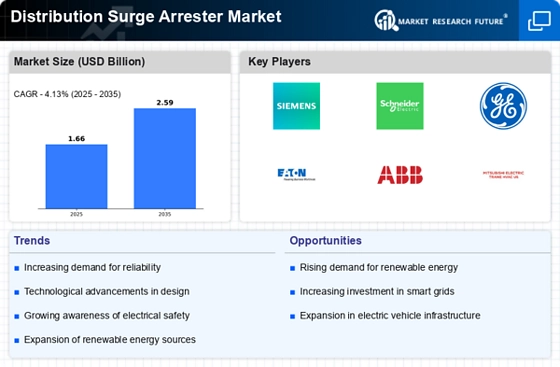Rising Demand for Renewable Energy
The increasing shift towards renewable energy sources, such as solar and wind, is driving the Distribution Surge Arrester Market. As more renewable energy installations come online, the need for effective surge protection becomes paramount. These systems are susceptible to voltage spikes, which can damage sensitive equipment. The surge arresters play a crucial role in safeguarding these installations, ensuring reliability and longevity. According to recent data, the renewable energy sector is projected to grow at a compound annual growth rate of over 8% in the coming years. This growth directly correlates with the rising demand for distribution surge arresters, as utilities and energy providers seek to protect their investments in renewable technologies.
Increased Investment in Smart Grids
The transition towards smart grid technologies is a significant driver for the Distribution Surge Arrester Market. Smart grids incorporate advanced communication and automation technologies, which enhance the efficiency and reliability of electricity distribution. However, these systems are also more vulnerable to voltage surges, necessitating the integration of effective surge protection solutions. As governments and utilities invest in smart grid infrastructure, the demand for distribution surge arresters is expected to rise. Recent reports indicate that the smart grid market is projected to grow substantially, with investments reaching hundreds of billions of dollars. This growth presents a lucrative opportunity for surge arrester manufacturers to cater to the evolving needs of modern electrical networks.
Expansion of Electrical Infrastructure
The ongoing expansion of electrical infrastructure in various regions is a key driver for the Distribution Surge Arrester Market. As urbanization accelerates, the demand for reliable electricity supply increases, necessitating the enhancement of existing power grids. This expansion often involves the installation of new substations and distribution lines, which require surge protection devices to mitigate the risk of voltage surges. Recent statistics indicate that investments in electrical infrastructure are expected to reach trillions of dollars over the next decade. Consequently, this surge in infrastructure development is likely to boost the demand for distribution surge arresters, as utilities prioritize the protection of their assets against transient overvoltages.
Growing Awareness of Electrical Safety
The increasing awareness of electrical safety among consumers and industries is driving the Distribution Surge Arrester Market. As organizations prioritize safety and reliability in their operations, the demand for surge protection devices has surged. This heightened awareness is particularly evident in sectors such as manufacturing, healthcare, and data centers, where equipment failure due to voltage surges can lead to significant financial losses. Market analysis indicates that the surge protection device market is expected to witness robust growth, driven by the need for enhanced safety measures. Consequently, this trend is likely to propel the demand for distribution surge arresters, as stakeholders seek to mitigate risks associated with electrical surges.
Technological Innovations in Surge Protection
Technological advancements in surge protection devices are significantly influencing the Distribution Surge Arrester Market. Innovations such as improved materials and designs enhance the performance and reliability of surge arresters. For instance, the development of metal oxide varistors (MOVs) has led to more efficient surge protection solutions. These advancements not only improve the lifespan of the devices but also reduce maintenance costs for utilities. Market data suggests that the adoption of advanced surge protection technologies is on the rise, with a projected increase in market share for high-performance surge arresters. This trend indicates a growing recognition of the importance of robust surge protection in modern electrical systems.


















Leave a Comment